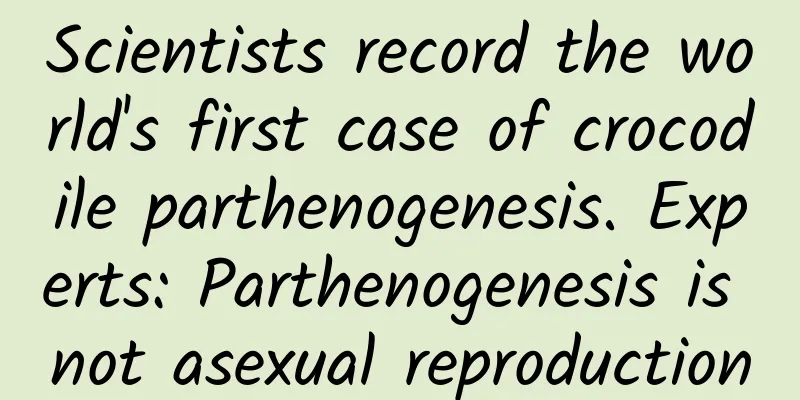Scientists record the world's first case of crocodile parthenogenesis. Experts: Parthenogenesis is not asexual reproduction

|
Recently, scientists from Virginia Tech in the United States recorded the first case of alligator parthenogenesis: in a zoo in Costa Rica, a female alligator, the American narrow-snouted alligator, who had lived alone for 16 years, suddenly laid 14 eggs. Scientists selected 7 eggs that had a chance of hatching and artificially incubated them, and finally obtained a fully formed alligator offspring, but this only hatched alligator did not survive. The relevant research results were published in the Journal of Biology Express. Researchers dissected the female crocodile baby that died at full term and sequenced its entire genome, and surprisingly found that it was more than 99.9% identical to its mother in terms of genes, which also means that this crocodile baby was definitely parthenogenetic. "Parthenogenesis, also known as asexual reproduction, is a reproductive method in which only females produce complete offspring without any genetic contribution from males. This phenomenon is extremely rare and has previously appeared in lizards and snakes. It is evidence of the existence of parthenogenesis in another evolutionary lineage of reptiles." Nie Liuwang, professor at the School of Life Sciences of Anhui Normal University, told Science Times. Belongs to sexual reproduction Nie Liuwang said that although parthenogenesis can say goodbye to "love troubles", it is not asexual reproduction. Asexual reproduction refers to a reproduction method that does not require the combination of sperm and egg, while parthenogenesis refers to a special reproduction method that only requires eggs but no sperm. "Although parthenogenesis does not involve the process of mating between female and male individuals, under normal circumstances, the early origins of these organisms were through sexual hybridization. Since hybridization disrupts the normal process of meiosis, the development of eggs has to choose another way, which is to allow the population to continue through parthenogenesis." Nie Liuwang further explained that asexual reproduction is often called cloning, such as hydra and jellyfish. They can produce new individuals through division, budding, and breakage, and the genetic material of their offspring is exactly the same as that of their parents. How is parthenogenesis achieved? In the process of sexual reproduction, both the egg cell and the sperm cell provide half of the genetic information needed to create an organism. A primary oocyte undergoes the first meiotic division to produce a secondary oocyte and a first polar body; the secondary oocyte undergoes the second meiotic division to produce an egg cell and a second polar body, and the first polar body undergoes the second meiotic division to produce two more polar bodies. Therefore, an oocyte will eventually produce a mature haploid egg cell (i.e., egg) and three polar bodies. "In parthenogenesis, some animals have found unique ways to fill in the genes that are usually provided by sperm cells." Nie Liuwang said that there are two mechanisms for parthenogenetic species: terminal self-fusion mechanism and nuclear mitosis mechanism. The former refers to the fusion of mature haploid egg cells with the second polar body to form offspring with almost homozygous genes, so it is a semi-clone of the mother; while the nuclear mitosis mechanism refers to the oocytes before meiosis, the genome doubles again, and then in the process of two consecutive meiosis, a diploid genome cell is produced. The result of nuclear replication is that the genotype of the offspring is highly consistent with that of the mother, which is a full "clone". Does parthenogenesis represent the end of evolution? Sexual reproduction is the main mode of reproduction for vertebrates. It can cause the genome to recombine, allowing offspring to have more heterogeneous genes and diverse genetic information, increasing the genetic diversity of species and improving the ability of species to adapt to changing environments. "Parthenogenesis has obvious disadvantages - lack of recombination of genetic material, inability to repair defective DNA, inability to purify harmful mutations, causing harmful mutations to accumulate in the gene pool, and inability to adapt to a changing environment, thus causing the species to quickly die out. Therefore, many researchers believe that parthenogenesis is the end of evolution and a dead end of evolution," said Nie Liuwang. In the past 20 years, the research literature on vertebrate parthenogenesis has grown dramatically. Nie Liuwang believes that the reason is that scientists have a deeper understanding of the nature of this phenomenon and the rapid development of molecular genetics, genomics and bioinformatics analysis technology. Today, researchers have discovered parthenogenesis or its variants in more than 100 species of vertebrates, including fish, amphibians, reptiles, and birds, indicating that parthenogenesis is widespread. "Molecular biological research shows that the offspring of parthenogenesis can improve their adaptability through rapid mutation and re-formation of polyploidy, thus maintaining the continuation of the species. Some species can also further reproduce by transforming into sexual reproduction. Therefore, parthenogenesis has a certain significance in evolution," said Nie Liuwang. |
<<: Who is taller, ancient or modern? The answer may be different from what you think!
Recommend
Controlled nuclear fusion energy: How far is humanity from achieving energy freedom?
On the afternoon of August 25, China National Nuc...
Understanding the current status and cutting-edge technologies of cloud databases in one article
"Everything will run in the cloud." Now...
Breathing in liquid, from the deep sea to space
380 million years ago, fish began to crawl onto l...
What to do if you lose your Apple AirPods? App to find your headphones is now available
Since Apple AirPods wireless Bluetooth earphones ...
Can those inconspicuous little holes on the eggshell actually cause big bugs on the dining table?
As the saying goes, flies don't bite seamless...
Why are marshmallows so much sweeter than regular candy? Here’s the secret…
During the Spring Festival, you can often see sta...
How much does it cost to customize the Xiangyang fabric mini program?
There are two types of customization for Xiangyan...
Precise positioning of Moments ads, do you want to know how WeChat sees you?
Do you want to know how WeChat sees you? Since th...
Understand MLM in one minute!
Source: Hunzhi...
I spent 20,000 yuan, why is there not a single conversion?
“I know that half the money I spend on advertisin...
Review of the TV version of the beautiful big-screen adventure "Dodo Escape"
Screen: Sound Effects: operate: Plot: Experience:...
Three major processes of Android View drawing
introduce The workflow of View mainly refers to t...
2019 Advertising Industry Mid-Year Observation
Advertising that is not aimed at growth is a hool...
"She loves to laugh so much, why does she suffer from depression?"
On the evening of July 5, singer Coco Lee’s siste...

![Tik Tok Hot Content Increase Follower Course [Taught by the Venomous Tongue Movie Partner]](/upload/images/67cc2fc11ad3a.webp)







